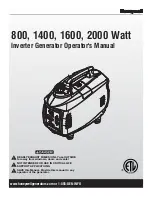
aXis CONTROLLER HOME STANDBY GENERATOR
INSTALLATION
27
CAUTION
A battery presents a risk of electrical shock and high short
circuit current.
The following precautions are to be observed when working on
batteries:
1. Remove watches, rings, or other metal objects,
2. Use tools with insulated handles,
3. Wear rubber gloves and boots,
4. Do not lay tools or metal parts on top of the battery
5. Disconnect charging source prior to connecting or
disconnecting battery terminals,
6. Determine the battery is inadvertently grounded. When
inadvertently grounded, remove source of ground. Contact
with any part of a grounded battery is capable of resulting
in electrical shock. The risk of such a shock is reduced
when such grounds are removed during installation and
maintenance (applicable to a generator not having a
grounded supply circuit.
WARNING
Do not dispose of battery or batteries in a fire. The battery is
capable of exploding.
WARNING
Do not open or mutilate the battery or batteries. Released
electrolyte has been known to be harmful to the skin and eyes
and can be toxic.
Vented Batteries
The installation of the engine generator shall provide enough
ventilation to ensure that all gases generated by vented batteries
during charging, or caused by equipment malfunction are
removed.
CAUTION
The electrolyte is a diluted sulfuric acid that is harmful to the
skin and eyes. It is electrically conductive and corrosive.
The following procedures are to be observed:
1. Wear full eye protection and protective clothing,
2. Where electrolyte contacts the skin, wash it immediately
with water,
3. Where electrolyte contacts the eyes, flush thoroughly and
immediately with water and seek medical attention, and
40 Spilled electrolyte is to be washed down with an acid
neutralizing agent. A common practice is to use a solution
of one pound (500 grams) bicarbonate of soda to one
gallon (4 liters) of water. The bicarbonate of soda is to be
added until the evidence of reaction (foaming) has ceased.
The resulting liquid is to be flushed with water and the
area dried.
WARNING
Lead-acid batteries present a risk of fire because they
generate hydrogen gas.
The following procedures are to be followed:
1. DO NOT SMOKE when near batteries.
2. DO NOT cause flame or spark in battery area, and
3. Discharge static electricity from body before touching
batteries by first touching a grounded metal surface.
10. WIRING Of THE HSB
Wire Sizing
All installations must comply with National, State and Local codes.
It is the responsibility of the installer to perform an installation that
will pass the final electrical inspection. Conductor wire sizes must
be adequate to handle the maximum current to which they will be
subjected. The installation must comply fully with all applicable
codes, standards and regulations.
All power cables must enter the enclosure through the knockouts
provided. If not using knockouts, conduit entry into the enclosure
must be at or below knockouts to maintain the Type 3R rating.
NEMA 3R enclosures are rated and tested for outside installation,
they are water proof enclosures and only come with knockouts on
the bottom side of the enclosure. If a NEMA 3R enclosure in used
for an inside installation, a greenlee type punch will be required to
make a knockout(s) on the side or top of the enclosure. Conduits
should be arranged to provide separation between the Utility
Source and HSB Source supply conduits inside the enclosure.
Conductor wires must be properly supported, of approved
insulated qualities, protected by approved conduit and of the
correct wire gauge size in accordance with all applicable codes.
















































